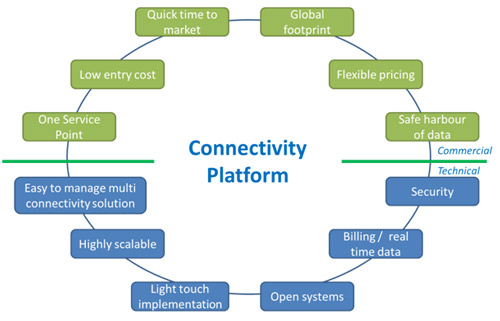The growth of connected devices in M2M and the Internet of Things – including sensors, devices, and systems – is set to be pervasive and to extend into all aspects of our society. Machina Research estimates that the number of M2M connected devices will grow from 3.5 billion in 2013 to 22.2 billion by the end of 2023[1], representing more than a six-fold growth in the period, as illustrated in Figure 1.
This vast estate of sensors, devices and systems will be developed and deployed hand-in-hand with an extensive, diverse and innovative range of M2M and IoT applications including personal healthcare monitoring solutions, construction site surveillance systems, smart meters, connected cars, remote monitoring solutions for manufacturing, and agricultural equipment, to name but a few. Each of these applications will perform specific and detailed tasks as defined by associated business rules and models.
The ability to connect to and manage devices in a resilient and scalable way is fundamental to M2M and many IoT solutions, and a range
of different kinds of platform have emerged to assist in this endeavour. Of all platform types, Connectivity Support Platforms (such as Jasper Technologies and Ericsson) are the highest profile. To date such platforms have been primarily cellular focused, and often enable and manage the tasks of initiating, configuring and activating SIMs. These platforms ensure that connectivity paths are managed and monitored, and provide some additional tools such as real-time connectivity status, reporting, troubleshooting and often SIM ordering and profile creation.
With M2M applications becoming ever more advanced and complex, and with the emergence of the IoT, platforms will need to change. Where previously connectivity support platforms supported connection to a narrow set of devices and primarily cellular connectivity options, future requirements can be characterised by increasing agility and flexibility.
We have already seen a similar trend in application development where abstraction has become a preferred approach for the emerging range of M2M/IoT Application Platforms[2]. We expect similar developments in the connectivity support platform space, characterised by an ever increasing technology agnosticism. This combination of abstraction and agnosticism allows for the scale and heterogeneity (of devices and protocols) to be managed through
fewer platforms, and enables developers to focus more on application development rather than specific communications technologies or device characteristics.
But the simple idea of a ‘technology agnostic’ connectivity support platform belies a complex and challenging task in managing the characteristics of multiple connectivity options. For example M2M solutions such as container freight tracking might require some combination of satellite, cellular and short-range connected devices. Supporting these different connectivity technologies with a single platform solution could be a significant benefit and differentiator for enterprises and operators, system integrators and providers of M2M/IoT Application platforms alike.
Managing different connectivity technologies is a complex task. Providers of multi-technology connectivity platforms face the challenge of working across different protocols, managing multiple billing, real time data and reconciliation functions, and ensuring secure and resilient communications across a range of communications technologies. Each connectivity technology will behave differently when it is ‘working properly’ and may require different actions when there is an error status. Accordingly, the ability to offer a well-defined and managed connectivity solution drawing in multiple connectivity technologies can be a significant competitive differentiator. For enterprises, such a solution removes much of the difficulty of integrating new connectivity options, and opens the door to new tariffing and billing options.
Twelve technical and commercial capabilities and features, as illustrated in Figure 1, define the ‘best practice’ elements for connectivity support platforms. Delivering these capabilities and features will ultimately reduce friction in the marketplace, enabling significant growth in connected devices, and providing improved ROI, which in turn open new markets and application development opportunities. In this space technical and commercial capabilities and features are closely related and these capabilities and features work together to bring about a single and comprehensive connectivity proposition.
However, it is clear that the ‘best practice’ capabilities and features listed are not the same as those typically cited for cellular connectivity support platforms. Such capabilities would typically include connection provisioning, usage monitoring and some level of support for network fault resolution. By contrast, the best practices listed here typically address higher level commercial, application development, application management and implementation considerations. Ultimately pursuit of best practice for a connectivity support platform results in a repositioning as a ‘Connectivity Platform’: actually providing connectivity, rather than simply supporting it.
Figure 1: ’Best Practice’ elements of connectivity platforms [Source: Machina Research
2014]
[1]Machina Research forecast database 2014
[2]For more detailed information on M2M/IoT Application Platforms read Machina Research Strategy Report on “Competitive Dynamics in the M2M Platform Space,” published in January 2014.

